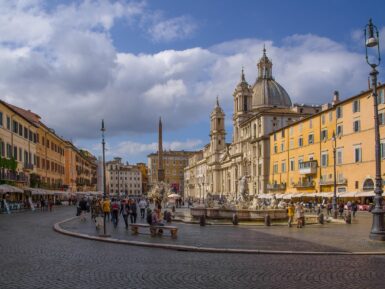Don’t miss tossing a coin in this iconic Trevi Fountain of Rome.
Table of Contents
1.History

The Trevi fountain is one of Rome’s ancient iconic landmark with a history dating back to ancient Rome. It is located at the endpoint of the Aqua Virgo an ancient Roman aqueduct built in 19 BC by Marcus Agrippa, which supplied fresh water to city’s bath and fountains. The name Trevi comes from Latin “Trivium” meaning “three roads” as the fountain is situated where three streets meet.
For centuries, the site featured a simple drinking fountain but in early 18th century, Pope Clement XII commissioned a grand redesign of Trevi Fountain. In 1732,Nicola Salvi won competition, but due to financial delays and his death the project took 30 years to complete, finally finished by Giuseppe Pannini in 1762.
Over the years it has undergone multiple restorations, including a 1998 cleaning project and a €2.2 million restoration by Fendi in 2014, restoring its original brilliance.
The Trevi fountain is deeply connected to Roman traditions and superstitions. The famous coin-throwing ritual dates back to ancient customs of offering to the gods of water for fortune.
Today, it is believed that tossing one coin ensures a return to Rome, two coins bring love, and three coins lead to marriage. This tradition has become so popular that approximately €3,000 is collected from the fountain daily, with the funds going to Caritas, a charity supporting Rome’s poor and homeless.
Today Trevi fountain remains one of the most visited and photographed landmarks in Rome, drawing millions of visitors who come to admire its majestic beauty and centuries-old traditions. If you’re exploring Rome, check out the 25 Best Things to Do in Rome for other must-visit attractions. After visiting Trevi, take a stroll to Campo de Fiori, a lively square known for its bustling market and charming cafes.
2. Architecture and Engineering
The trevi fountain is a stunning Baroque masterpiece, designed to look like a natural waterfall flowing from a grand palace. The fountain is 26.3 meters (86 feet ) high and 49.15 meters (161 feet) wide, making it the largest fountain in Rome. If you’re fascinated by Rome’s Baroque architecture, a visit to Piazza Navona is a must—another spectacular square featuring grand fountains, intricate sculptures, and historic charm

The fountain design is centered around Oceanus the god of water standing in a shell shaped chariot pulled by two sea horses. One horse is clam while the other is wild symbolizing the changing nature of the sea. Around him, Tritons and statues represent health, abundance, and the importance of water. The huge central arch is inspired by ancient Roman triumphal gates, giving the fountain a grand and powerful look.
Trevi fountain water comes from the Aqua Virgo aqueduct which has supplied fresh water to Rome since 19 BC. The fountain’s hidden underground pipes create a smooth and continues water flow making it feel like a natural spring. The large water basin at the bottom helps control the force of the falling water, preventing spalshing and keeping the fountains beauty intact.
The fountain is made of travertine stone, the same material used for the Colosseum, which gives it its warm, natural color and durability. The rocky base is designed to look like a natural landscape, adding depth and movement to the design. If you are interested in exploring Rome’s ancient wonders check out Trio of Colosseum, Roman Forum, and Palatine Hill.
3. Best time to Visit Trevi Fountain
The best time to visit Trevi fountain will be early morning before 8 AM or late night after 10 PM to avoid crowds and get the best photos. For pleasant weather and fewer tourists the months of September and October.

4. Photography Tips
1. Instead of taking the usual frontal shot move to the right side of the fountain to capture Oceanus the cascading water and the palazzo Poli in one frame.
2 .There is a small staircase on the right side of the fountain – climb up to get a slightly elevated angle that showcases the fountain’s depth while avoiding crowds in the foreground.
3. Capture the classic coin toss moment by standing behind the person tossing the coin focusing on their hand movement while keeping the fountain in the background. This adds a storytelling element to your shot.
4. After light rain or late at night the wet cobblestones in front of the fountain create a mirror-like effect making for a stunning moody reflection shot. Stand farther back and use a low angle to enhance the glow of the light on the water.
The Pantheon, located a short walk from the Trevi Fountain, also offers incredible photography opportunities.
5. FAQ’s
What is special about the Trevi Fountain?
Trevi fountain is the largest Baroque fountain in Rome, famous for its stunning sculptures, flowering water and coin throwing tradition which is believed to bring visitors back to Rome.
What is the myth behind the Trevi Fountain?
The legend says tossing a coin over your left shoulder with your right hand ensures a return to Rome. Tossing two coins brings love, and three coins leads to marriage.
How much money is in the Trevi Fountain per day?
Around €3,000 per day (over €1.5 million per year) is collected and donated to Caritas a charity that helps Rome’s poor and homeless.
Who is the guy in the middle of the Trevi Fountain?
The central figure is Oceanus, the god of all water, depicted riding a shell-shaped chariot pulled by two sea horses, symbolizing the changing moods of the sea.





Leave a reply